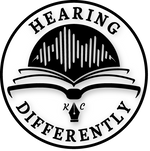When I got my cochlear implant at seven years old, I hated it. I did not want to hear. I was accustomed to a muffled, almost silent world. My implant introduced me to a myriad of sounds all at once.
My itinerant teacher, Faye, fought many battles with me to keep my cochlear on. It wasn’t just the sounds that I hated, it was that I couldn’t distinguish which sound was what. In my last post, I talked about Auditory Verbal Therapy (AVT) and how it taught me to speak. AVT taught me to detect, discriminate, identify and understand the many aspects of spoken language.
What Hearing Was Like at First
With my cochlear, I could hear sounds. But the cochlear I had at the time, the 1997 SPrint speech processor, did not have the ability to shift sounds in and out of focus. This meant that I could hear everything all at once.
This experience can be hard to describe to those with regular hearing, so ’ll try my best.
Imagine standing in front of a calm ocean. You close your eyes for a moment, and when you open them, a fifty-foot-tall wave is crashing down on you. When I turned on my cochlear, it was like a wave of sound crashing down on me.
Faye used AVT to help me discriminate those sounds, and to properly identify them.
A Typical ‘Listening’ Session
I would sit down with Faye, and play listening games with her. These games helped with four things:

At the beginning of my AVT therapy, one activity that Faye and I did was the ‘syllable game.’ Faye put five toy animals in front of me – an elephant, a duck, a tiger, a mouse and a giraffe – words that varied in syllable number and acoustic properties (and the sounds those animals made as well). I had to match the animal with the sound.
This progressed to me listening to stories and answering questions about those stories.
I also did constant listening tests. I used to go to Sick Kids Hospital in Toronto and do listening activities as well. One vivid memory I have is sitting in a colorful room full of stuffed animals that played all types of sounds.
Side note: I’m pretty sure this memory is vivid because I always (and still) find stuffed animals creepy. I thought that room was evil.
I would sit in the middle of this room, and be instructed to keep my eyes closed. Anytime a stuffed animal would make a noise, I would have to point in the direction the sound was coming from. The goal was to help me learn how to orient myself in noisy environments.
How I Listen Today
My hearing is by no means perfect, but I am able to distinguish sounds with ease except for the occasional time when I mess up certain sounds like a tea kettle whistling and a text ringtone, or I’d be with a friend in the car and if I’m looking away, think that they are speaking when it’s actually someone on the radio.
When that happens, I make a mental note of the sounds and that same mistake doesn’t happen again.
Thanks to my AVT, and the successes I had with it, I went from hating my cochlear implant, to loving and appreciating what it gave me – the ability to hear.

